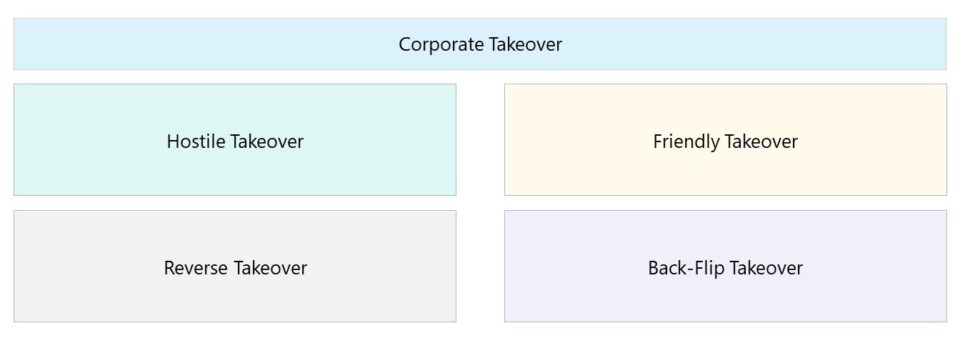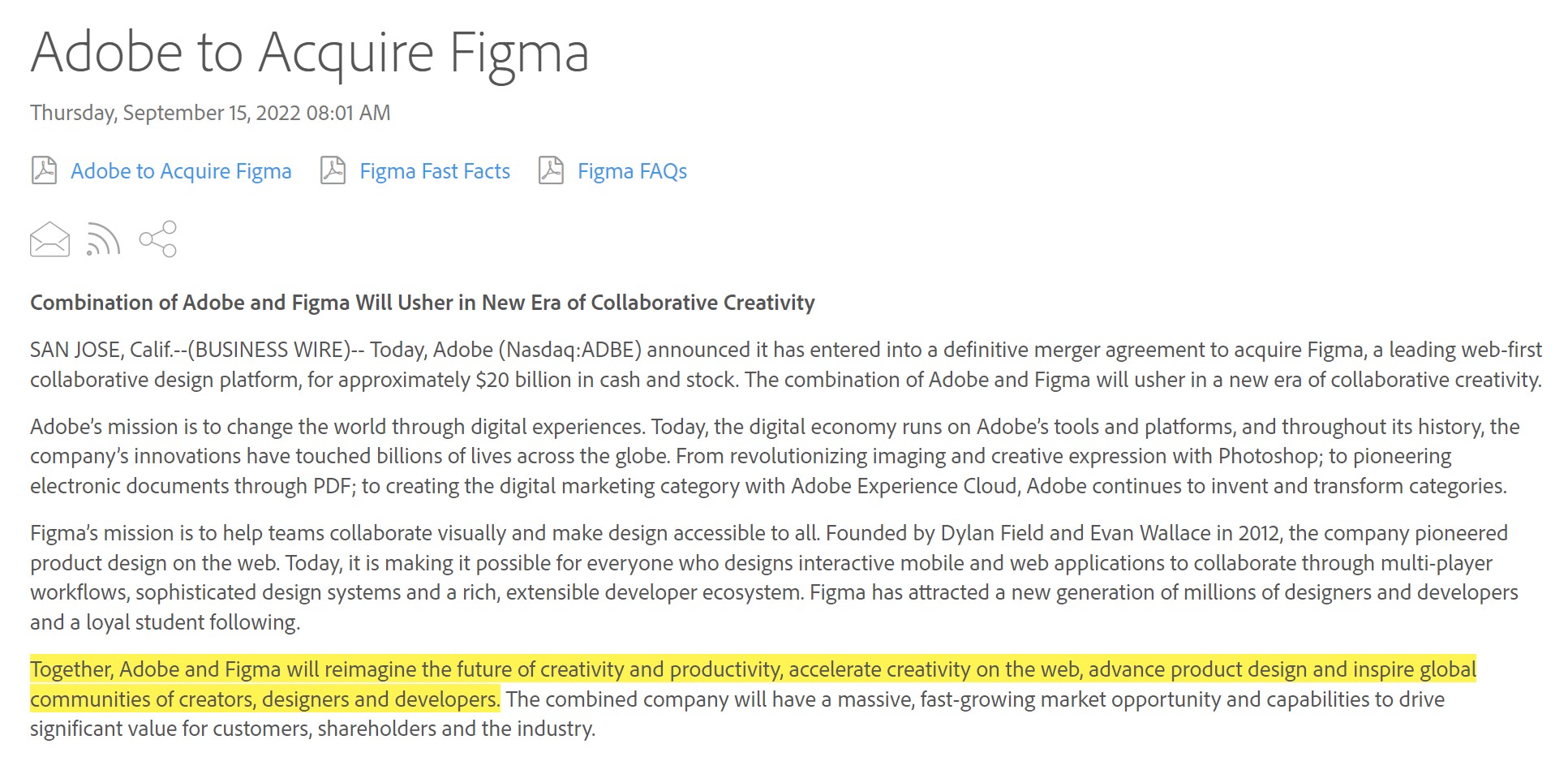- What is Corporate Takeover?
- How Does a Corporate Takeover Work?
- What is the Corporate Takeover Process?
- Hostile Takeover vs. Friendly Takeover: What is the Difference?
- What are Reverse Takeover and Backflip Takeover Bids?
- What are the Risks of Corporate Takeovers?
- What is an Example of a Corporate Takeover?
What is Corporate Takeover?
A Corporate Takeover describes an acquisition of a company, in which the acquirer obtains a controlling stake in the target.

How Does a Corporate Takeover Work?
A corporate takeover occurs when a strategic or financial buyer acquires a majority stake in a target company.
Corporate takeovers can be categorized as hostile or friendly, which is based on the receptiveness of the target company’s management team and board of directors to the initial acquisition offer, i.e. their openness to consider the offer and negotiate the terms.
- Friendly Takeover → A friendly takeover occurs if the target company’s management team and board of directors are open to the offer and agree to be acquired.
- Hostile Takeover → In a hostile takeover, both the management and the board reject the initial offer to acquire the target company. The buyer might back out in response, or continue to pursue the acquisition, which sets the premise of a hostile takeover.
The profile of the acquirer is often a strategic buyer or financial buyer in such M&A takeover transactions.
- Strategic Buyers in M&A → Strategic acquirers engage in corporate takeovers, specifically for the potential long-term revenue and cost synergies related to consolidating a market, offering a more comprehensive, improved mix of products and services, increased expansion to end markets (i.e. more reachability to customers), and the removal of competition.
- Financial Buyers in M&A → In contrast, financial buyers – namely, private equity firms (PE) – participate in corporate takeovers to achieve a specific investment return on behalf of their limited partners (LPs), i.e. the investors that provided the firm with the capital to engage in such activities.
What is the Corporate Takeover Process?
The process of a corporate takeover is complex, but from a high level, the following list summarizes the general timeline:
| Timeline | Description |
|---|---|
| 1. Tender Offer |
|
| 2. Internal Meetings |
|
| 3. Hiring of 3rd Party Advisory |
|
| 4. Negotiation of Terms |
|
| 5. Shareholder Vote Meeting |
|
Hostile Takeover vs. Friendly Takeover: What is the Difference?
Corporate takeovers, as mentioned earlier, can be classified as either a friendly takeover or a hostile takeover:
- Friendly Takeover → The target company’s management and board of directors – in most friendly takeovers – might understand the merits of the acquisition and the synergies rationalizing the offer, i.e. the revenue benefits and cost savings from the business combination. The negotiation process is not necessarily easier, but the two parties are more open to arriving at amicable terms, resulting in a higher probability of closure (and fewer complexities, such as M&A defense tactics like the poison pill defense).
- Hostile Takeover → On the other hand, a hostile takeover tends to follow an unsuccessful attempt at a friendly bid and subsequent collapsed negotiations with the company’s executives. However, the bidder – despite objections from management and the board – can still pursue the acquisition by directly reaching the shareholders and convincing enough of them to vote in favor of the acquisition.
Generally speaking, most shareholders who actively participate and vote tend to trust management’s guidance, unless there have been recent events that have transpired, causing an erosion in trust in management’s judgment and decisions (i.e. stock price decline, less shareholder value creation).
In a proxy fight, the hostile acquirer attempts to convince a sufficient percentage of existing shareholders to vote against the existing management team to complete the proposed acquisition.
One critical factor here in terms of shareholder sentiment is the recent performance of the company in terms of its earnings reports and stock price, as underperformance tends to work in favor of the hostile bidder.
The Wharton Online and Wall Street Prep Private Equity Certificate Program
Level up your career with the world's most recognized private equity investing program. Enrollment is open for the Feb. 10 - Apr. 6 cohort.
Enroll TodayWhat are Reverse Takeover and Backflip Takeover Bids?
Two other less traditional types of corporate takeovers include reverse takeovers and back-flip takeovers:
- Reverse Takeover: In a reverse takeover, a privately-held company assumes a controlling stake in a publicly traded company. The objective of the acquirer is to “go public” without undergoing an initial public offering (IPO), which can be time-consuming and costly. Thus, the private company targets a public company, which can either be a shell company or an operating company. For example, the return of Dell to the public markets would be an example of the latter.
- Back-Flip Takeover: In a back-flip takeover, the transaction rationale is similar to a reverse takeover (i.e. to become publicly listed), but the distinction is that the acquirer becomes a subsidiary of the target post-closing.
What are the Risks of Corporate Takeovers?
The main types of risks associated with corporate takeovers include: Anti-Trust Regulations, Activist Inventors, and Cross-Border M&A Regulatory Bodies.
- Antitrust Violations → While not applicable to all M&A transactions, regulatory agencies like the U.S. Department of Justice (DOJ) could potentially step in and further complicate matters. The potential for antitrust violations – i.e. engaging in business practices that discourage fair competition in the free markets – is a major concern for U.S. regulatory bodies, as seen in the case of Microsoft’s ongoing attempt to acquire Activision Blizzard.
- Activist Investors → Recent underperformance and a declining share price could contribute to the erosion of trust in management’s judgment among shareholders. In such scenarios, an external risk that could disrupt the acquisition is an activist investor that raises valid criticism of a given M&A transaction and could sway enough votes to oppose the deal.
- Cross-Border M&A → Furthermore, cross-border M&A is closely monitored by U.S. regulatory bodies like the Committee on Foreign Investment in the United States (CFIUS), especially for M&A activity conducted by China in recent years.
What is an Example of a Corporate Takeover?
In September 2022, the news was announced that Adobe (Nasdaq: ADBE) would acquire product design platform Figma at a $20 billion valuation.
- Acquirer → Adobe (ADBE)
- Target → Figma (Private)
According to Adobe’s press release, the acquisition was completed to expand the product portfolio and improve Adobe’s Creative Cloud suite by integrating Figma’s real-time collaboration and rapid prototyping capabilities.
Adobe to Acquire Figma (Source: Adobe Press Release)
Figma, led by CEO Dylan Feld, had increasingly built its name in the design space, in which its collaborative design tools had made its offerings a rival to Adobe.
The target of the corporate takeover, Figma, is not publicly-traded, whereas Adobe is a public company.
The press release from Figma, written by Feld, stated that “Adobe is deeply committed to keeping Figma operating autonomously, and I will continue to serve as CEO” – which implies the friendly nature of the transaction, where the terms of the deal were amicable to both parties.
The market landscape in design had shifted from individual contributions to collaboration-based work, which was the niche in which Figma’s platform appeared to take notable share away from Adobe.
Therefore, Adobe’s takeover of Figma puts them at the forefront of innovative creative design and workplace collaboration-oriented tools, while removing a fast-growing competitor from the market that had presented a major threat.
2023 Adobe and Figma Takeover Update
The European Union (EU) recently announced an anti-trust probe into Adobe’s proposed acquisition bid of Figma, on the basis that the deal could “reduce competition in the global markets for the supply of interactive product design software and for digital asset creation tools.”
Adobe’s expectation to close the Figma takeover in 2023 is still attainable, however, the odds seem to be stacked against Adobe considering the acquisition is under investigation by the U.S. and now the European Union (EU).







